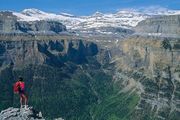
Sparsely populated, the old kingdom of Aragon is flanked by several worlds: France, Catalonia, Navarra and the northeastern reaches of Spain’s Castilian heartland. If you love mountains, castles and stone villages, this place is for you. You do need a vehicle to make the best of it, though, as its major rewards come from exploring in villages, small towns and sparsely populated mountain an country areas. Aragon is an ancient land composed of three provinces: Zaragoza ; remote Teruel , which is farther south and Huesca ;
Most of Aragon constitutes terra incognita for the average tourist- which is unfortunate, since it is one of the most historic regions of Spain. The one big city, Zaragoza (Saragossa), has a warmth and a collection of monuments and sights that may make you linger longer than you planned and one of the most-visited destination in the region, the reason being because it lies on the main route between Madrid and Barcelona. The Aragon Pyrenees forms the central region of Spanish Pyrenees in Huesca, in the northern Aragon province. The Pyrenees reaches its highest peaks in Aragon, which include Aneto (3,404 m), Monte Perdido (3,355 m), Maladeta (3,308 m), Tres Sorores (3,353 m) and Posets (3,375 m).
Being so close to the mountains, it is ideal for summer Trekking and winter Skiing. Along the valleys and down into the lower pre-Pyrenees hills is an intriguing mix of canyons, pretty villages, lonely castles and venerable monasteries, with some outstanding Romanesque architecture.
Central Aragon consists mainly of a series of treeless depressions and forlorn plateaus. It was the scene of some of the nastiest fighting in the civil war, and the two sides could hardly have chosen a more comfortless place to do combat. Further south, though, you reach other, thinly peopled mountain regions, sprinkled with picturesque, mysterious villages. The towers of Teruel, the south’s biggest town, are among the master-pieces of Spanish Mudejar architecture.
In Muslim times, what’s now Aragon was the northernmost salient of Islamic territory, with semi-independent governors in Zaragoza ruling over the Ebro valley and the Pyrenees foothills. The Christian kingdom of Aragon, beginning as a Frankish feudal county (Jaca) before becoming a self-proclaimed kingdom. Gradually expanded till it managed to drive the Muslims out of all modern-day Aragon by 1200. Aragon and neighbouring Catalonia were united by royal marriage in the 12th century, creating the Crown of Aragon. The Kings of Aragón ruled territories that consisted of not only the present administrative regions of Aragón and Catalonia, but also the Balearic Islands, Valencia, Sicily, Naples, Sardinia, Athens and Neopatria. Aragon united with Castile in the 15th century under their respective monarchs Fernando and Isabel, Los Reyes Catolicos, or the Catholic Monarchs, the union effectively gave birth to what we know as Spain. Ranking with Fernando El Catolico as Aragon’s most famous son in Francisco Goya, born near Zaragoza in 1746. Goya’s artistic oeuvre is well represented in Aragon.
In folklore, Aragon is known for the jota, a bounding, leaping dance performed by men and women since at least the 1700s. Various local culinary specialities are much touted: Ternasco (lamb ribs) is a standard local dish, while virutas de jamon (ham shavings) make an occasional appearance as the millionth variation on the Spanish pig theme. Aragon produces a good selection of wines. The Somontano and the Cariñena are among the best.